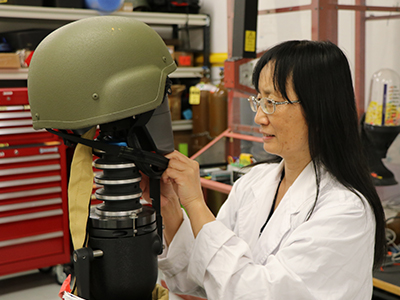Breaking open the science of helmet ballistic protection

Defence Science and Technology (DST) researcher Ping Tan has played a key role in undertaking work that focuses on the ballistic performance of body armour, and recently helmets.
According to Tan, increasing protection while significantly decreasing weight is critical to military helmet function. This can be achieved by optimally configuring helmets and carefully selecting materials.
"For this reason, it is important to understand how helmet shells with different material properties, hybridisations and geometries handle various projectile impacts," Tan explains.
"Physical experiments are very expensive, so our aim is to develop a modelling capability to help understand the armour behaviour through computer simulation.
"This has developed into a capability to help us understand the behaviour of armour material and ensembles against various blast loadings and ballistic and fragment impact."
Extra layer of ceramic protection
"My analysis aimed to predict how a ceramic layer added to Kevlar fibre-reinforced composite helmet shells might improve their performance," says Tan.
"My three-dimensional modelling of military helmets was validated by comparing the predicted results with those previously reported from theoretical studies and physical experiments."
It is known that a layer of ceramic material added to composite body armour material can quite significantly improve the ballistic performance of that armour. Generally helmets these days are made of composite materials, so would there be a similar benefit in adding a ceramic plate to a helmet? And how does the curvature of the helmet affect the situation?
Tan found very few studies in the open literature on the modelling and simulation of the effects of the material properties and configurations on the ballistic performance of military helmet shells and even less consideration has been given to hybrid composite helmets composed of a ceramic strike face and a fibre-reinforced composite backing layer.
Developing a capability
"What I have been doing is developing a capability to accurately simulate the ballistics of different, adjoining types of material," explains Tan.
Tan says eventually this sort of understanding could help to develop an Australian capability to manufacture curved composite body armour including helmets. Her model considers two common ceramics – boron carbide (used for tank armour and bulletproof vest plates) and silicon carbide (used in car brakes and clutches and also bulletproof vest plates).
The analysis predicts the boron carbide/Kevlar composite hybrid helmet shell would have better ballistic protective performance than the same helmet without ceramics and also better performance than the hybrid helmet that used a similarly-sized silicon carbide ceramic plate.

